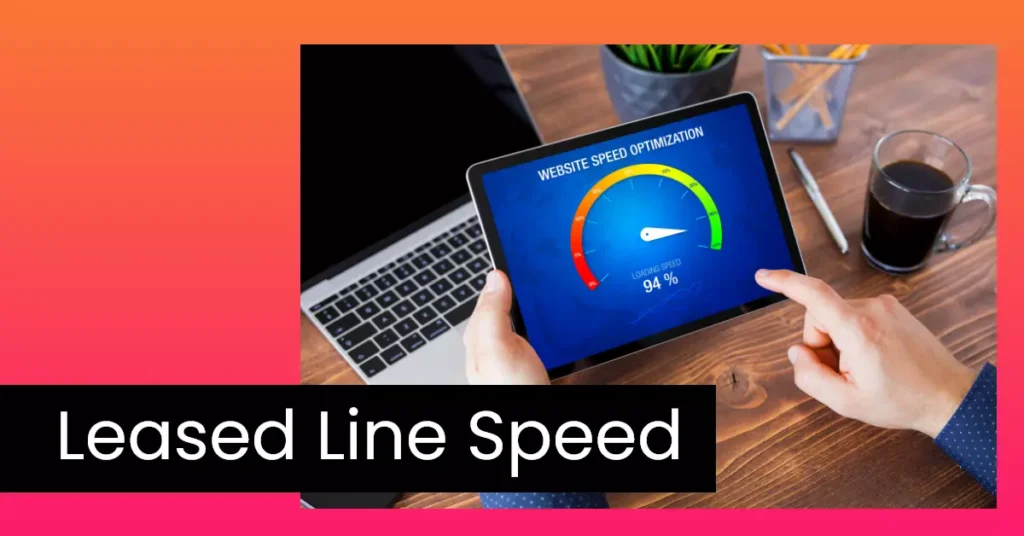A Complete Understanding Of Leased Line Speed

What is your most important concern when considering getting a new internet connection? For some, it is reliability or low latency for others, it is contention ratio and speed. It is a topic that is definitely up for debate, but what we think is that leased line speed or internet connection speed is becoming highly important for businesses as well as homes.
With the advancement of technology, users have come to expect a certain level of service from the providers they choose to work with, which means having the ability to transfer, share and recall data has never been more important.
Fibre leased lines are now considered the fastest form of internet connection available in the UK. But while internet access speed is a key, many businesses are still struggling to understand all the things about leased line speeds.
One important thing is to understand the difference between leased line bearers and speeds so that you know how you can use them to customise your internet connection.
What Is Leased Line Speed?
You receive the speed of data transfer from your internet service provider. With traditional broadband, the speed you receive is usually slower than the speed that your internet service provider has advertised. It happens due to contention.
However, you can get a guaranteed speed with a leased line connection. You will get the speed for which you have paid. In addition, it offers the same upload and download speed.
If you have a broadband connection, even if it is superfast fibre broadband, at peak time, the connection speed is slow. The more the number of users sharing the same internet connection, the slower the speed will be. We recommend that you run a speed test through reputable speed checkers at various times of the day to get accurate results.
Unlike broadband connection, a leased line speed will not slow down or fluctuate during peak times. Leased line providers guaranteed speeds through their SLA (Service Level Agreements). They monitor your connection 24/7 to fix problems before you notice them.
Leased Line Bearer Speed?
A leased line bearer means the pipe through which you get a connection, and it tells you the maximum bandwidth you can get on the bearer. Bearer speed shows the maximum speed that a fibre leased line can provide. In other words, we can say that it is a silent bandwidth that sits in the background and waits to be used when needed.
For example, if you order a 50MB leased line on a 100MB bearer, you are able to upgrade your connection to 60Mb, 70Mb right the way upto 100Mb whenever you need.
One significant benefit of having a bearer is that you are future-proofing your internet connection. It provides you with peace of mind that if you need more bandwidth during your term of the contract, you can upgrade.
Which Leased Line Speed Should You Pick?
Choosing the right leased line speed for your business is one of the most important decisions. You must keep in mind your business needs before ordering a leased line.
You may find a number of options present in the market but be aware of the bandwidth and speed you need before signing a contract. Typically leased line providers offer contracts of two or three years. What if you ordered a leased line with 100MB speed and signed a contract for 3 years but need more bandwidth now? You have to pay a cancellation fee if you want to cancel the contract before time.
With the modern working environment, businesses need more bandwidth to complete their day-to-day operations. The popularity of leased line speeds changes every year. The most common speed used by businesses is 100Mb on a 1Gb bearer.
However, with the increasing demand for ultra-fast speed, the leased line with 1Gb speed is also becoming popular. By seeing the current situation, we can say with certainty that within a few years, it will become the “go-to” speed.
How To Check Your Leased Line Speed?

There are two different ways to check your leased line speed. One is a quick and simple method that may not provide accurate results. The other way is detailed and time-consuming, but it provides more reliable results.
Let’s take a closer look at these two methods of checking leased line speed.
1. Simple Way To Check Leased Line Speed
This method may not provide accurate results for speeds above 10Mbps. In order to check your connection speed, follow the steps below:
- In order to get the most accurate result, plug the laptop directly into the router given by your leased line provider. Suppose possible run speed tests outside of your working hours so that no employee is using the internet at the same time as you.
- Visit free online leased line speed testing tools such as SpeedTest (be careful to click on speed test instead of ads that try to get you to scan your computer).
- Click on Begin test.
2. Detailed Method To Check Leased Line Speed
If you want to get more accurate results from the speed test, follow the steps below:
- Contact your leased line provider to schedule a speed test.
- At the scheduled time, your provider will connect a network monitoring tool like iperf to the end of your leased line.
- Most probably, you want to run a series of tests. You will want to coordinate the tests so that for any given test, one of your laptops is running as an iperf server and the other acts as a client.
Both laptops must have fast Network interference cards so that these cards do not create bottlenecks. Always keep in mind that your leased line speed may not match the speed at which you are experiencing the internet. Most of your internet traffic not only travels from your leased line to the internet service provider and vice versa. It travels beyond your internet provider’s network to the wider internet.
It connects to the wider internet via peering links or links provided by IP transit providers. Congestion on such links can slow down traffic, and as a result, leased line speed appears slower than the actual speed. It is a reason that the result of many online leased line speed tests is not always useful. It is especially true when you run a speed test for leased lines above 10Mbps speeds. Furthermore, you may be charged for speed tests if they involve a site visit by your leased line provider.
What If Your Leased Line Speed Is Not Fast Enough?
If your leased line speed is slower than your expectations, there are a number of scenarios that can affect your connection test.
One possibility is that many users are using the connection at the time when you are running the speed test. That is why experts recommend running a speed test outside of business hours.
Alternatively, if certain traffic is being prioritized while conducting the speed test, it can also affect leased line speed. Moreover, some computer/ laptop network interface cards are not efficient enough to carry out an accurate connection test.
If you find that your current leased line package needs to upgrade in order to meet your business needs, connect your leased line provider and check out the latest offers.
Final Words - Leased Line Speed
While many businesses get high speed through fibre broadband connection, a leased line connection can unlock even higher speeds. With the increased use of cloud-based applications, businesses are looking for reliable and ultrafast connectivity solutions. Leased line speeds are high enough to meet the current needs of businesses. It is also a great way to future-proof your internet connection to support your growth. You must determine your business needs, shop around and make price comparisons to find the right leased line speed at an affordable rate.
Read More : Leased Line Vs VPN Security
Read More : Leased Line Costs, Quotes & Prices in 2022



